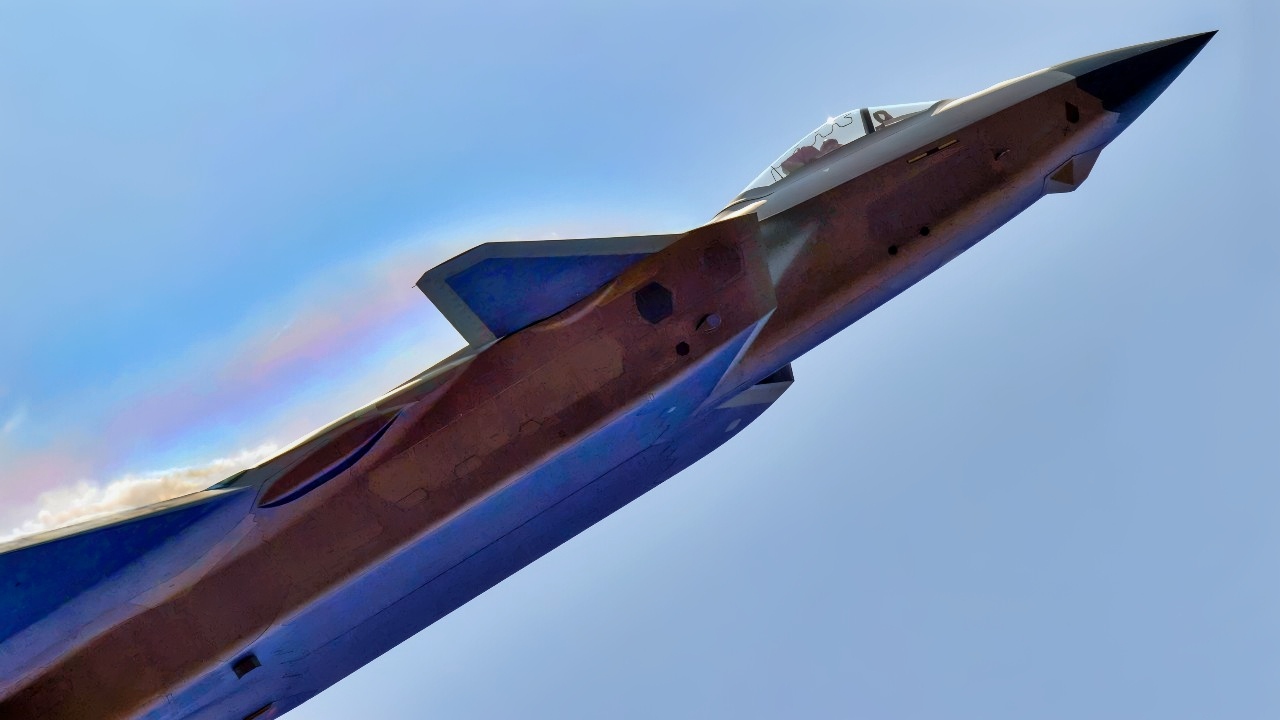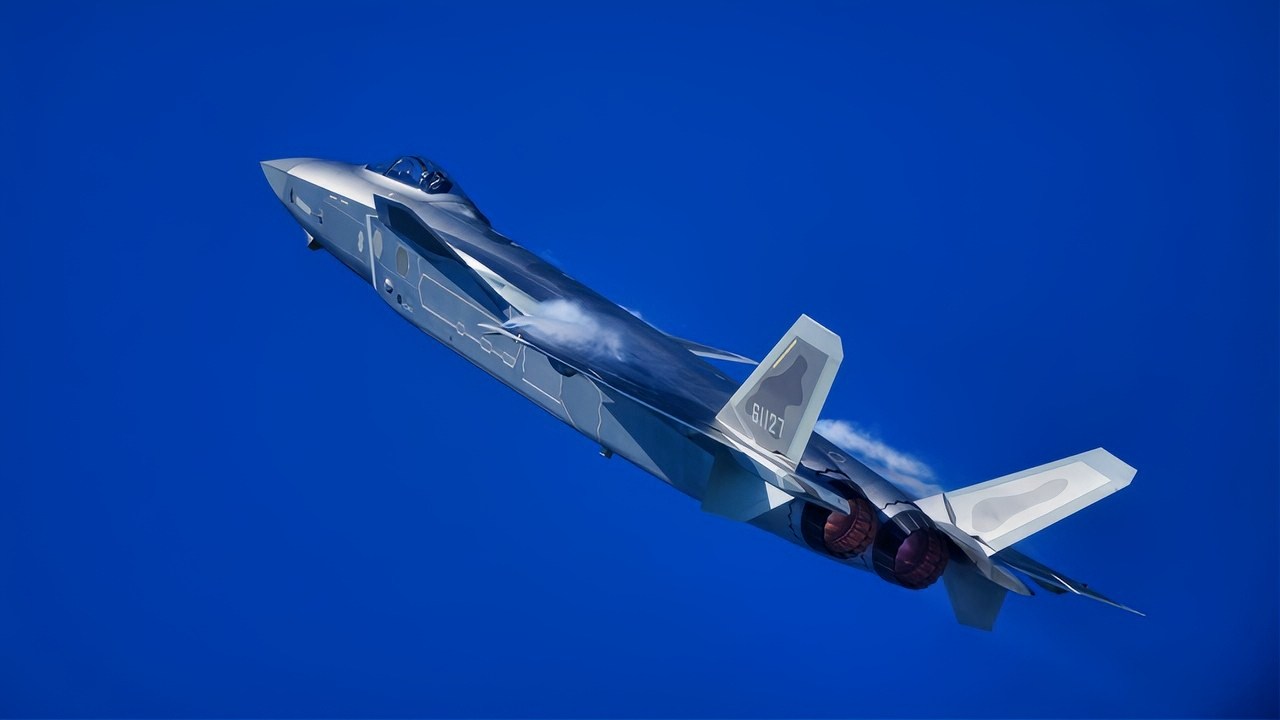Key Points and Summary – China’s J-20 stealth fighter has five key weaknesses, particularly in its earlier variants.
-It suffers from underpowered and unreliable engines, with the advanced WS-15 facing long delays.

China’s J-20 Fighter. Image Credit: Creative Commons.
-Its stealth is compromised by exposed engine nozzles and a large airframe, making it less stealthy than its U.S. rivals.
-The J-20’s avionics and sensor fusion are likely inferior, and its large size makes it a poor dogfighter.
Not Fixable: The J-20 has zero combat experience, meaning its true capabilities remain unproven and purely theoretical, unlike its battle-tested American counterparts.
5 Reasons China’s J-20 Stealth Fighter Could Fail in a Real War
The Chengdu J-20 Mighty Dragon is China’s first and arguably most advanced stealth fighter. Built to combat the F-22, the fighter is designed primarily for air superiority. However, despite being designed to combat American stealth fighters, the J-20 falls short in a couple of areas.
Here are the five worst attributes of the J-20 which could put it at a disadvantage in combat. Just as a disclaimer, most of these apply to earlier variants of the J-20. China has since improved many aspects of the aircraft.
Questionable Engine Performance
One of the most critical issues facing the J-20 is its engine. Early production models were powered by Russian AL-31F engines, which were not designed for stealth aircraft and lacked the thrust and efficiency needed for sustained supersonic flight without afterburners.
China later transitioned to its domestically produced WS-10C engines, which offered some improvements but still fell short of the performance benchmarks set by Western fifth-generation fighters. The WS-10C has been criticized for its limited thrust-to-weight ratio, reliability concerns, and inability to support long-duration supersonic flight.
China’s next-generation engine, the WS-15, is intended to solve these problems and enable true supercruise capability.
However, the WS-15 has faced years of development delays, technical setbacks, and endurance issues during testing. Although recent reports suggest that the WS-15 is finally entering serial production, only a small number of J-20s are believed to be equipped with it, and its operational reliability remains unproven.
These engine limitations directly impact the aircraft’s combat readiness, sortie rates, and ability to perform in high-intensity conflict scenarios.
Stealth Compromises
Another major problem with the J-20 lies in its stealth design. While the aircraft is marketed as a stealth fighter, its radar cross-section is significantly larger than that of the F-22 or F-35, particularly when viewed from the side or rear.

J-20. Image Credit: Creative Commons.
Initially, Western analysts blamed this on the canard configuration. However, simulations show that the canards are actually fairly well blended into the fighters structure, and do not contribute to its higher RCS. It is engine nozzles on most J-20 variants which are exposed and lack the serrated edges or shielding found on Western stealth aircraft, that increase its radar visibility.
The overall airframe is also larger than its American counterparts, which can make it easier to detect. Compounding these design issues is China’s frequent public showcasing of the J-20, including flyovers and airshow appearances. These displays allow adversaries to gather valuable data on the aircraft’s radar signature and flight characteristics, undermining its ability to operate undetected in contested environments. As a result, the J-20’s stealth capabilities are not as robust or comprehensive as those of its Western rivals, limiting its survivability in high-threat zones.
Subpar Avionics?
The third major issue concerns the J-20’s avionics and sensor fusion. While the aircraft is equipped with an advanced active electronically scanned array (AESA) radar and electro-optical targeting systems, its ability to integrate and process data from multiple sensors likely fall short to that of the F-35 and F-22.
Sensor fusion is a critical component of fifth-generation warfare, enabling pilots to receive a unified, real-time picture of the battlespace. In the J-20, this integration appears to be less seamless, resulting in reduced situational awareness and slower reaction times.
Although Chinese sources claim that the J-20’s radar can detect targets at ranges up to 700 kilometers using advanced silicon carbide processors, these claims are difficult to verify and may not reflect actual combat performance.
Furthermore, the aircraft’s electronic warfare systems are believed to be less sophisticated than those of Western fighters, making it more vulnerable to jamming and spoofing. The centralized command structure of the People’s Liberation Army Air Force (PLAAF) may also limit pilot autonomy, reducing the effectiveness of the aircraft in dynamic combat situations where split-second decisions are crucial.

China J-20 Long Shot from 2021. Image Credit: Chinese Military.
Weak in WVR Engagements
The J-20 suffers from limitations in maneuverability and close-range combat. This is arguably not really a flaw due in large part to the aircraft’s role in the PLAAF. The aircraft is designed primarily for long-range interception and air superiority missions, with an emphasis on engaging targets at distance using advanced missiles like the PL-15.
Its large size, canard configuration, and lack of thrust-vectoring in most variants make it less agile than the F-22, which excels in high-G maneuvers and dogfighting.
The J-20’s design prioritizes range and payload over agility, which is fine for its role, but it puts it at a disadvantage in rare visual-range engagements where quick turns and evasive maneuvers are essential. The J-20 also lacks an internal gun system, further reducing its effectiveness in close combat.
These limitations mean that the J-20 is heavily reliant on its long-range sensors and weapons to avoid dogfights altogether. Again, this is fine for the intended role the J-20 fills. It just makes it less versatile than the F-35 or even the Su-57.
No Combat Experience
A common thread you may have noticed is that none of the claims made about the aircrafts avionics, engine metrics, or stealth capabilities can be verified. Unlike the F-22 and F-35, which have participated in numerous joint exercises and real-world combat missions, the J-20 has never been tested in actual warfare.
Even the Su-57, which is built in much smaller numbers, has had more combat experience than the J-20. Its performance remains largely theoretical, based on simulations and scripted training scenarios.

Su-75 Checkmate and Su-57. Image Credit: Creative Commons.
This lack of empirical data makes it difficult to assess how the aircraft would perform under the stress and unpredictability of combat. Additionally, the J-20 has not been exported to any foreign air forces, nor has it participated in multinational exercises that would allow for benchmarking against peer platforms.
This isolation limits the feedback loop necessary for iterative improvements and raises questions about the aircraft’s interoperability and adaptability. Without combat experience or external validation, the J-20’s capabilities remain speculative, and its operational effectiveness is uncertain.
About the Author: Isaac Seitz
Isaac Seitz, a Defense Columnist, graduated from Patrick Henry College’s Strategic Intelligence and National Security program. He has also studied Russian at Middlebury Language Schools and has worked as an intelligence Analyst in the private sector.
More Military
Russia’s ‘Black Hole’ Kilo-Class Submarine Has a Message for the U.S. Navy
How a Russian Pilot Defected With A Mach 2 MiG-29 Fulcrum Fighter
The F-4 Phantom II Has a Message for Any Air Force on Earth
The F-16 Fighting Falcon Fighter Has a Message For Any Air Force on Earth










